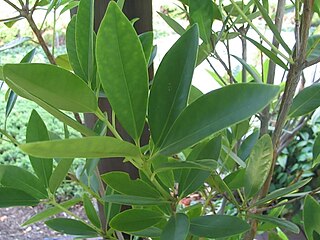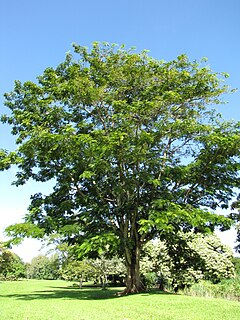
Illicium verum is a medium-sized evergreen tree native to northeast Vietnam and southwest China. A spice commonly called star anise, staranise, star anise seed, star aniseed, star of anise, Chinese star anise, or badian that closely resembles anise in flavor is obtained from the star-shaped pericarps of the fruit of I. verum which are harvested just before ripening. Star anise oil is a highly fragrant oil used in cooking, perfumery, soaps, toothpastes, mouthwashes, and skin creams. Until 2012, when they switched to using a bacterial source, Roche Pharmaceuticals used up to 90% of the world's annual star anise crop to produce shikimic acid, a chemical intermediate used in the synthesis of oseltamivir (Tamiflu).

Taiwania, with the single living species Taiwania cryptomerioides, is a large coniferous tree in the cypress family Cupressaceae.

Pinus thunbergii, also called black pine, Japanese black pine, and Japanese pine, is a pine tree native to coastal areas of Japan and South Korea.

Abies procera, the noble fir, also called red fir and Christmas tree, is a species of fir native to the Cascade Range and Pacific Coast Ranges of the northwestern Pacific Coast of the United States. It occurs at altitudes of 300–1,500 meters (980–4,920 ft).

Cupressus bakeri, reclassified as Hesperocyparis bakeri, with the common names Baker cypress, Modoc cypress, or Siskiyou cypress, is a rare species of cypress tree endemic to a small area across far northern California and extreme southwestern Oregon, in the western United States.

Parmentiera cereifera, the candle tree, is a species of tree in the family Bignoniaceae. It is endemic to Panama, but it is also a commonly cultivated specimen in botanical gardens.

Abies forrestii is a species of conifer in the family Pinaceae, endemic to China. It is named after the Scottish botanist and plant-hunter George Forrest (1873–1932), who discovered it for western science in Yunnan province. Its common names include Forrest's fir.

Picea glehnii, the Sakhalin spruce or Glehn's spruce, is a species of conifer in the family Pinaceae. It was named after a Russian botanist, taxonomist, Sakhalin and Amur river regions explorer, geographer and hydrographer Peter von Glehn (1835—1876), the person who was the first to describe this conifer. In Japan people call this tree アカエゾマツ, which means “red spruce”.

Brunfelsia portoricensis, the Puerto Rico raintree, is a species of flowering plant in the family Solanaceae. It is endemic to Puerto Rico, where it occurs in El Yunque National Forest.

Eugenia haematocarpa is a rare species of plant in the family Myrtaceae. It is endemic to Puerto Rico. It is classified as an endangered species by the U.S. Fish and Wildlife Service and there has been a plan for its recovery in place for some years. Its common names include uvillo and Luquillo Mountain stopper.

Eugenia woodburyana is a species of plant in the family Myrtaceae. It is endemic to Puerto Rico. It is a federally listed endangered species of the United States. It is threatened by habitat loss.
Illicium peninsulare is a species of plant in the family Schisandraceae. It is a tree endemic to Peninsular Malaysia. It is threatened by habitat loss.
Illicium tenuifolium is a species of flowering plant in the family Schisandraceae. It is a tree native to Indo-China and Peninsular Malaysia. It grows in tropical forests, including cloud forests.
Melicope ovalis, the wild pelea or Hana melicope, is a species of tree in the family Rutaceae. It is endemic to Maui, of the Hawaiian Islands.
Pleodendron macranthum (chupacallos) is a rare species of tree in the family Canellaceae. It is endemic to Puerto Rico, where there are only three tiny populations remaining. Two individual plants are located in El Yunque and 8 to 10 plants remain in Río Abajo State Forest. This tree is a federally listed endangered species of the United States.

Illicium floridanum is an evergreen shrub native to the Gulf Coast area of the Southern United States, from Florida to Louisiana.

Arctostaphylos glauca is a species of manzanita known by the common name bigberry manzanita. It is native to California and Baja California, where it grows in the chaparral and woodland of coastal and inland hills.

Illicium parviflorum, commonly known as yellow anisetree, yellow-anise, swamp star-anise, and small anise tree, is a species of flowering plant in the family Schisandraceae, or alternately, the Illiciaceae. It is native to Florida in the United States. It historically occurred in Georgia as well, but it has been extirpated from the state.

Ceriops tagal, commonly known as spurred mangrove or Indian mangrove, is a mangrove tree species in the family Rhizophoraceae. It is a protected tree in South Africa. The specific epithet tagal is a plant name from the Tagalog language.

Parkia timoriana is a species of flowering plant in the legume family. English common names include tree bean. It is native to Thailand, Malaysia, Myanmar, Indonesia, and Assam and Manipur in India. It is widely cultivated for food and wood, and as an ornamental.
















